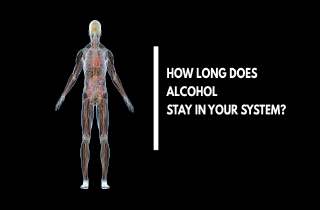ARTICLE OVERVIEW: Different people react differently to alcohol. That is because a variety of factors can influence your unique metabolism. Here, we review the time needed for alcohol to leave our bodies and why it is often longer than we think. We invite your questions about the duration of alcohol metabolism at the end.
TABLE OF CONTENTS
- General Effects
- Metabolism Basics
- Factors
- Metabolism Process
- One Alcohol Unit
- Peak Levels
- Alcohol Poisoning
- Blood, Breath, Hair, Saliva and Urine Sample Tests
- At Home Tests
- Signs Of A Problem
- Alcohol Lasts How Long?
General Effects
At first, alcohol often makes people feel relaxed and happy. Upon continued drinking, however, alcohol can lead to impairment of brain activity and result in difficulty walking, slurred speech, memory lapses, and impulsive behavior. Why is this?
When a person drinks, the concentration of alcohol in the blood builds to a peak, then goes down. When alcohol crosses the blood-brain barrier and starts to affect the central nervous system, it affects mood and/or behavior by interacting with neurotransmitters in the brain; this makes it harder to think clearly and move with coordination. In fact, alcohol can affect parts of the brain that control movement, speech, judgment, and memory.
After an initial period of euphoric effect during alcohol intoxication, additional consumption can cause:
- Anxiety
- Fainting
- Headache
- Loss of the sense of orientation
- Memory loss
- Mood changes
- Numbness that lead to vomiting
- Risk behavior and accidents
Further, excessive alcohol consumption can seriously affect the system, especially the liver, brain and heart. Liver inflammation and scarring, brain shrinking, heart damage, intoxication are just some of the side effects of abnormal drinking, with coma or death being the ultimate result of overdose or chronic drinking.
Metabolism Basics
Many people can enjoy a drink or two on a night out, but have you ever wondered how long a drink stays in your system? On the other hand, does it take you more than a few hours to become sober after binge drinking? The answer to these questions depends upon your body’s unique reaction and metabolism of alcohol.
Alcohol is fairly quickly absorbed into the bloodstream. It passes from the blood into all tissues and fluids in proportion to their relative content of water. However, the way alcohol is metabolized depends on many factors, including gender.
Factors that Influence Alcohol Metabolism
Other factors that influence alcohol metabolism include:
- Acute or chronic alcohol consumption.
- Age.
- Amount of alcohol consumed.
- Ethnicity.
- Food.
- How often you drink.
- Mixing alcohol with other drugs.
- Type of alcohol that is consumed.
- Weight.
- Your genetic background and family history.
- Your physical health.
Let’s look into some of the variables a little more closely. Very young people have low alcohol elimination rates because the enzyme that breaks down alcohol is not fully expressed in their bodies. What else influences metabolism?
Heavy drinking can increase alcohol metabolic rate, but advanced liver disease due to chronic alcohol consumption will decrease the rate of alcohol metabolism. Furthermore, the rate of alcohol elimination varies with the time of day, being maximal at the end of the daily dark period. This may be related to a body temperature cycle; this is also related of high elimination rate when the person is doing exercise.
Drugs, which inhibit ADH (pyrazoles, isobutyramide) or compete with ethanol for the enzyme that breaks down alcohol will decrease rate of alcohol elimination. For example, Antabuse (disulfiram) also slows alcohol metabolism by inhibiting the elimination of acetaldehyde. Alcohol metabolism is also higher in the fed nutritional state as compared to the fasted state. There is a faster rate of alcohol elimination by women when rates are corrected for lean body mass (lean body mass = body weight – body fat). Some studies, but not all, suggest an increased rate of alcohol elimination by Native Americans compared to Caucasians.
Metabolism Process
Less than 10 % of alcohol is eliminated in breath, sweat, and urine. Almost 90 % alcohol is removed from the body by oxidation and most of this alcohol oxidation occurs in the liver thanks to the action of an enzyme called alcohol dehydrogenase (ADH). In fact, alcohol stays in your bloodstream until it is broken down by the liver thanks to the action of ADH.
The reason that alcohol levels build up in your system is that, for most people, it is absorbed into the system more rapidly than it is metabolized. Gender differences also account for this. First pass metabolism of alcohol by the stomach, for example, may be greater in males, and can contribute to the higher blood alcohol levels found in women.
One unit of alcohol stays in the body for about 2 hours after being consumed.
One Alcohol Unit
How long alcohol lasts in the body is directly tied to how much your drink. So, it can be helpful to define what we mean by one alcohol unit, or one drink. One unit of alcohol is roughly 0.6 fluid ounces of pure alcohol. A single drink can be defined as:
- One 12-ounce can or bottle of regular beer, ale, or wine cooler.
- One 8- or 9-ounce can or bottle of malt liquor.
- One 5-ounce glass of wine.
- One 1.5-ounce shot glass of hard liquor.
Still, you cannot speed up the process of getting drinking out of your system. Depending on how much you drink, you need from 1-24 hours for alcohol to totally clear your body.
Peak Levels
The amount of alcohol in your blood is called your “blood alcohol concentration”, or, BAC. And the higher your blood alcohol concentration (BAC) level or the amount of alcohol present in your bloodstream, the more impaired you become by alcohol’s effects.
For a person weighing 150 pounds, one drink will increase blood-alcohol concentration about 0.02 percent, but the body can only remove about 0.016 percent per hour. Therefore, even if you consume only one drink per hour, your BAC is going to continue to increase. If you drink more than one drink per hour, it rises much more rapidly.
Generally, effects of alcohol usually appear within 10 minutes and then peak at maximum an hour after consumption. Furthermore, acute effects of alcohol last for as long as you continue drinking. Still, the effects of alcohol may be extended if a person has previously eaten food high in carbohydrates and fat.
Some of the main effects of peaks levels of alcohol by BAC include:

Drinking too much can lead to a hangover, a set of symptoms which occur after drinking too much alcohol. Most hangovers are gone within 24 hours after the last drink. Recovery can take up to 72 hours, however, and consists of consuming liquids, lots of rest, and time.
Alcohol Poisoning
While the effects of alcohol and elimination rate vary from person to person, any person who overdose on alcohol can present “alcohol poisoning”. Alcohol poisoning occurs when there is so much alcohol in the bloodstream that areas of the brain which control basic functions (breathing, heart rate, and temperature control) begin to shut down. Alcohol poisoning requires immediate medical help.
Blood, Breath, Hair, Saliva, and Urine Sample Tests
Blood alcohol levels, breathalyzer test results, urine drug screens, and, less commonly, hair and saliva analysis can be used to assess patients for possible alcohol and other drug use. However, these tests cannot establish an unequivocal diagnosis of a drinking problem. More on that in the paragraphs below. Still, blood alcohol levels may confirm tolerance, and may confirm the origin of coma or confusion.
Blood: Blood samples show the most accurate representation of BAC of all testing methods and are used as supplementary testing to compensate for the known weaknesses of breath testing. Alcohol can show up in a blood test up to 12 hours after your last drink.
Breath: The breathalyzer measures the amount of alcohol in exhaled breath to estimate the amount of alcohol in a person’s blood. The maximum level of alcohol that may be accurately detected by evidential breath testers is 220 μg/100 ml air. Alcohol can be detected for up to 24 hours after your last drink.
Hair: Like other drugs, alcohol can be detected with a hair follicle drug test for up to 90 days.
Saliva: A saliva test can be positive for alcohol from one to five days.
Urine: Alcohol can be detected in urine for 3-5 days via ethyl gluconoride (EGT) metabolite or 10 to 12 hours via traditional method.
These tests may be useful in evaluating an adolescent with school problems, or in accidents, domestic violence, or other trauma situations. Testing for alcohol may be controversial, so it is advisable to obtain the person´s (and/or parents’) permission before initiating such screens. Furthermore, blood, urine, and saliva studies add a crucially important dimension to the effectiveness of alcoholism treatment programs. Testing adds structure and establishes limits that are critical aspects of helping patients regain self-control and self-respect.
At Home Tests
You can measure your own breath alcohol level with a simple handheld breathalyzer device. If the device is calibrated and used according to the manufacturer’s directions, it can provide an accurate estimate of your blood alcohol level. There are different types of devices available. You can get simple devices meant for home use and professional devices like those used by police for suspected drunk drivers.
You can find a list of FDA approved breathalyzer tests here.
Signs of a Problem
The following may be signs of a drinking problem. Often, you cannot see them yourself. So, it’s up to others who actually notice them:
- Decreasing alcohol tolerance.
- Felling palpitations after drinking.
- Imperious need of alcohol.
- Irritability.
- Nervousness
- Tremors.
- You know when you start drinking, but you have no idea how everything ended.
- You bail on your responsibilities.
- You become ridiculous or anti-social when drinking.
Your Questions
We hope to have covered some of the basics for alcohol testing here. If we have not answered your question directly, please let us know. Or if you think that you may have a drinking problem or perhaps another alcohol-related issue, please submit your question or comment below. We will be happy to help and try to respond to all legitimate concerns personally and promptly.










Related Posts